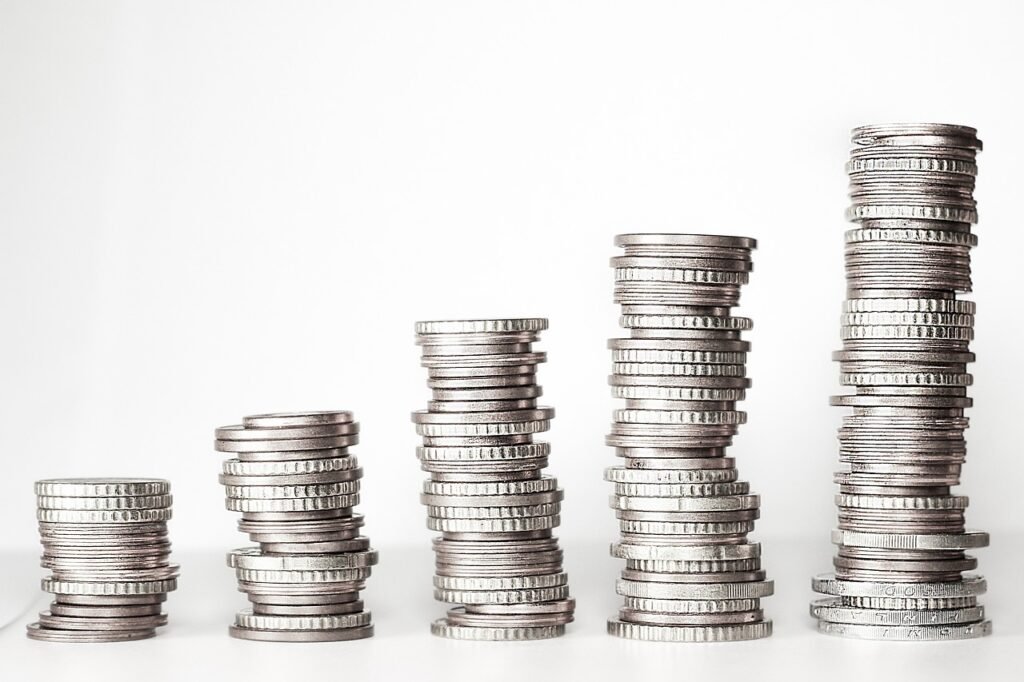Have you ever dreamed of doubling your money without lifting a finger? It sounds too good to be true, but there’s a financial secret that can make this dream a reality: compound interest. 🪄💰
Imagine planting a money tree that grows exponentially, branching out and multiplying your wealth year after year. That’s the magic of compound interest. But here’s the kicker: you don’t need to be a financial wizard to harness this power. With the right knowledge and strategy, you could potentially double your money in just 7 years!
In this blog post, we’ll unravel the mystery behind compound interest and reveal the simple yet powerful “Rule of 72.” We’ll explore the factors that can turbocharge your financial growth, share practical strategies to achieve your money-doubling goals, and examine real-world applications of this financial phenomenon. But beware – we’ll also shed light on potential pitfalls to ensure you’re well-equipped to navigate the world of compound interest. Ready to unlock the secret to financial growth? Let’s dive in!
Understanding Compound Interest

A. Definition and basic concept
Compound interest is a powerful financial concept that can significantly accelerate wealth accumulation. It refers to the process of earning interest on both the initial principal and the accumulated interest from previous periods. This compounding effect creates exponential growth over time, making it a crucial tool for long-term savings and investment strategies.
B. How it differs from simple interest
| Feature | Simple Interest | Compound Interest |
|---|---|---|
| Calculation | Based on principal only | Based on principal and accumulated interest |
| Growth | Linear | Exponential |
| Time impact | Less significant | More significant |
| Long-term benefit | Lower | Higher |
Unlike simple interest, which calculates interest solely on the principal amount, compound interest offers a more substantial return by continuously reinvesting the earned interest. This fundamental difference makes compound interest a superior choice for long-term financial goals, such as retirement planning or building substantial wealth.
C. The exponential growth effect
The true magic of compound interest lies in its exponential growth effect. As time passes, the rate at which your money grows accelerates, creating a snowball effect. This phenomenon is best illustrated through a practical example:
- Initial investment: $10,000
- Annual interest rate: 7%
- Compounding frequency: Annually
- Year 1: $10,700
- Year 5: $14,026
- Year 10: $19,672
- Year 20: $38,697
As you can see, the growth becomes more pronounced over time, demonstrating the power of compound interest in wealth building. This exponential growth is why many financial experts emphasize the importance of starting to save and invest early, allowing compound interest to work its magic over extended periods.
The Rule of 72: Simplifying Compound Interest

Explanation of the Rule of 72
The Rule of 72 is a simple yet powerful tool in the world of finance, offering a quick way to estimate how long it will take for an investment to double in value. This rule states that you can divide 72 by the annual interest rate to approximate the number of years required for your investment to double.
| Interest Rate | Years to Double |
|---|---|
| 1% | 72 years |
| 4% | 18 years |
| 8% | 9 years |
| 12% | 6 years |
How to use it for quick calculations
Using the Rule of 72 is straightforward:
- Identify the annual interest rate or expected return on your investment
- Divide 72 by this percentage
- The result gives you the approximate number of years to double your money
For example, if you have an investment earning 6% annually, divide 72 by 6. The result, 12, indicates it will take about 12 years for your investment to double.
Limitations and accuracy
While the Rule of 72 is a useful estimator, it’s important to understand its limitations:
- It’s most accurate for interest rates between 6% and 10%
- For rates outside this range, slight adjustments may be needed
- It doesn’t account for factors like taxes or inflation
Despite these limitations, the Rule of 72 remains a valuable tool for quick mental calculations in financial planning. Now that we understand this simplified approach to compound interest, let’s explore the factors that can affect its growth in real-world scenarios.
Factors Affecting Compound Interest Growth

A. Interest rate
The interest rate is a crucial factor in compound interest growth. Higher interest rates lead to faster growth, while lower rates slow down the compounding effect. Here’s a comparison of how different interest rates affect the growth of a $10,000 investment over 7 years:
| Interest Rate | Value After 7 Years |
|---|---|
| 5% | $14,071 |
| 7% | $15,007 |
| 10% | $19,487 |
As you can see, even a small increase in the interest rate can significantly impact your investment’s growth over time.
B. Frequency of compounding
The frequency of compounding refers to how often interest is calculated and added to your principal. More frequent compounding leads to faster growth. Common compounding frequencies include:
- Annually
- Semi-annually
- Quarterly
- Monthly
- Daily
For example, a $10,000 investment at 7% interest compounded monthly will grow to $15,225 after 7 years, compared to $15,007 if compounded annually.
C. Time horizon
The time horizon is another critical factor in compound interest growth. The longer you leave your money to grow, the more powerful the compounding effect becomes. This is why starting to invest early is so important for long-term wealth building and retirement planning.
D. Initial investment amount
While not directly affecting the rate of growth, the initial investment amount plays a significant role in the final outcome. A larger initial investment will naturally result in a larger final amount, even if the growth rate remains the same. This underscores the importance of saving and investing as much as possible early on to maximize the benefits of compound interest.
Now that we’ve explored the factors affecting compound interest growth, let’s look at some practical strategies to leverage these factors and potentially double your money in 7 years.
Strategies to Double Your Money in 7 Years

A. Determining the required interest rate
To double your money in 7 years, you need to calculate the required interest rate using the Rule of 72. Here’s how:
- Divide 72 by the number of years (7)
- The result is the annual interest rate needed
72 ÷ 7 ≈ 10.29%
Therefore, you need an annual return of approximately 10.29% to double your money in 7 years. This rate can guide your investment decisions.
B. Choosing the right investment vehicles
Selecting appropriate investments is crucial for achieving the required 10.29% annual return. Consider these options:
| Investment Type | Potential Return | Risk Level |
|---|---|---|
| Index Funds | 7-10% | Moderate |
| Growth Stocks | 10-15% | High |
| Real Estate | 8-12% | Moderate |
| Bonds | 2-5% | Low |
A diversified portfolio combining these investments can help balance risk and return.
C. Maximizing compounding frequency
Increase your money’s growth potential by maximizing compounding frequency:
- Choose investments that compound more frequently (e.g., daily or monthly)
- Reinvest dividends automatically
- Consider high-yield savings accounts for short-term funds
D. Reinvesting dividends and returns
Reinvesting dividends and returns accelerates wealth accumulation:
- Set up automatic dividend reinvestment plans (DRIPs)
- Redirect investment income back into your portfolio
- Avoid the temptation to withdraw gains prematurely
By consistently reinvesting, you harness the full power of compound interest and increase your chances of doubling your money in 7 years.
Now that we’ve explored strategies to double your money, let’s examine some real-world applications of compound interest.
Real-World Applications of Compound Interest

A. Retirement savings
Compound interest plays a crucial role in retirement savings, making it one of the most powerful tools for securing your financial future. By starting early and consistently contributing to retirement accounts, you can harness the power of compound interest to build a substantial nest egg over time.
Here’s a comparison of retirement savings with and without compound interest:
| Years | Initial Investment | Annual Contribution | Without Compound Interest | With Compound Interest (7% return) |
|---|---|---|---|---|
| 10 | $10,000 | $5,000 | $60,000 | $88,698 |
| 20 | $10,000 | $5,000 | $110,000 | $245,066 |
| 30 | $10,000 | $5,000 | $160,000 | $566,765 |
As you can see, compound interest significantly boosts your retirement savings, especially over longer periods.
B. Debt repayment
Compound interest can work against you when it comes to debt, particularly credit card debt. However, understanding its mechanics can help you develop effective repayment strategies:
- Pay more than the minimum: This reduces the principal faster, decreasing the amount of interest that compounds.
- Debt avalanche method: Focus on high-interest debts first to minimize overall interest payments.
- Consolidate debts: Transfer high-interest debts to lower-interest options to reduce compounding effects.
C. Education funds
Compound interest is a valuable ally when saving for education expenses. 529 plans and other education savings accounts leverage compound interest to grow your contributions over time.
D. Wealth building
Compound interest is the cornerstone of long-term wealth building. By reinvesting dividends and capital gains, investors can accelerate their wealth accumulation. This strategy is particularly effective in index funds and dividend-paying stocks, where returns are automatically reinvested to purchase more shares, creating a snowball effect of growth.
Now that we’ve explored real-world applications, let’s consider some potential pitfalls and important considerations when relying on compound interest for financial growth.
Potential Pitfalls and Considerations

A. Inflation effects
Inflation can significantly impact the real value of your investments over time. While compound interest works to grow your money, inflation erodes its purchasing power. To illustrate:
| Year | Investment Value | Inflation Rate | Real Value |
|---|---|---|---|
| 0 | $10,000 | 2% | $10,000 |
| 7 | $14,000 | 2% | $12,276 |
As shown, even though your investment grew to $14,000 in 7 years, its real value is only $12,276 due to inflation. To combat this:
- Aim for returns that outpace inflation
- Consider inflation-protected securities
- Diversify your portfolio to hedge against inflation risks
B. Tax implications
Taxes can take a bite out of your compound interest gains. Different types of accounts and investments have varying tax treatments:
- Tax-deferred accounts (e.g., traditional IRAs, 401(k)s)
- Tax-free accounts (e.g., Roth IRAs)
- Taxable accounts (e.g., regular brokerage accounts)
Understanding these implications is crucial for maximizing your after-tax returns. Consider consulting with a tax professional to optimize your investment strategy.
C. Risk vs. return trade-offs
While higher returns can accelerate compound interest growth, they often come with increased risk. It’s essential to:
- Assess your risk tolerance
- Diversify your portfolio to spread risk
- Rebalance periodically to maintain your desired risk level
D. Market volatility impact
Market fluctuations can affect short-term performance and potentially impact your long-term goals. To mitigate this:
- Maintain a long-term perspective
- Consider dollar-cost averaging to smooth out market ups and downs
- Have an emergency fund to avoid selling investments during market downturns
Now that we’ve explored these potential pitfalls, let’s look at some real-world applications of compound interest to see how these principles play out in practice.
Conclusion

Compound interest is a powerful financial tool that can significantly impact your wealth accumulation over time. By understanding the Rule of 72 and implementing effective strategies, you can potentially double your money in just seven years. However, it’s crucial to consider factors such as interest rates, investment frequency, and potential risks that may affect your compound interest growth.
As you embark on your journey to financial growth, remember that compound interest is not a guaranteed path to wealth. Stay informed, diversify your investments, and consult with financial professionals to make informed decisions. By harnessing the magic of compound interest and applying it wisely, you can set yourself on a path to long-term financial success and security.

